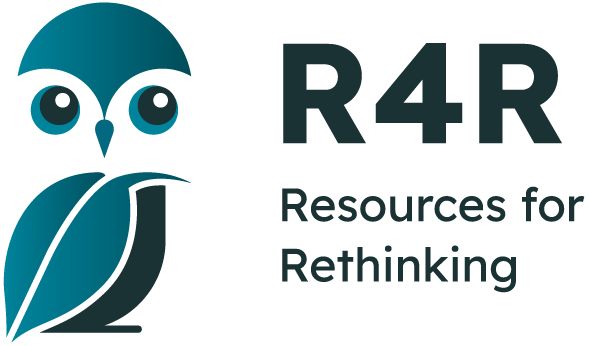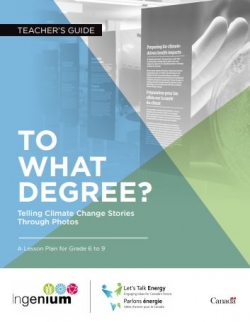Search for Resources
Description
Through a series of four lessons, students will learn the story of how climate change is impacting life in Canada today. The students will be working with photos from the exhibition "To What Degree? Canada in a Changing Climate".
Lesson 1: How do we adapt to and prevent climate change?
- Opens with a value line activity, to brainstorm and discuss prior knowledge of climate change
- Work in groups to categorize activities as either adaptation or mitigation
- Students connect actions and activities they see locally as examples of adaptation and/or mitigation
Lesson 2: A picture tells a thousand stories
- Opens with a Family Feud competition, to talk about how different actions have different impacts on mitigating climate change
- Explore how photos can effectively tell a story on the environment and climate change
- Analyze photos from the exhibit, then create word clouds and captions for one of the images
- Share their created captions and the real caption is revealed
Lesson 3: Researching climate change
- Delve deeper into one of the photos and conduct research to get a bigger picture of the story
- A ‘first steps’ list of news articles, infographics, and videos from the government, news sources, etc. are provided as a starting point (as needed)
- Present back to others on the story, with more information in a Museum Walk format.
Lesson 4: Climate change in our words and photos
- Work together as a class on a climate change photo exhibition of their own
- Tell a local/global story with their own photos or research, or approach it as an art project
- Research background information and create captions
- Share and display with other classes, the school, and ideally the greater community
General Assessment
What skills does this resource explicitly teach?
This resource is based on the idea of developing an awareness of climate change instead of specific skills.
Strengths
This resource has the following strengths:
- Interesting and engaging activities for all learning styles
- Good quantity of information for the teacher
- Links to additional videos and additional resources that will allow the class to investigate issues on a deeper level
- Evaluation suggestions for both formative and summative data for each lesson
- All materials are provided
- An interesting final project that the students will enjoy
Weaknesses
There were no obvious or glaring weaknesses with this resource.
Recommendation of how and where to use it
This resource would be beneficial as a mini-unit for a class to begin to explore the topic of climate change. You may wish to use the lesson plans in order or pick and choose activities or discussions from them to accompany your teaching plan.
Relevant Curriculum Units
The following tool will allow you to explore the relevant curriculum matches for this resource. To start, select a province listed below.
- Step 1Select a province
- Alberta
- Step 2Select a grade level
- Grade 6
- Step 3Select a subject
- Science
- Step 4Relevant matches
- Earth Systems: Understandings of the living world, Earth, and space are deepened through investigating natural systems and their interactions.
- Grade 7
- Step 3Select a subject
- Science
- Step 4Relevant matches
- Interactions and Ecosystems
- Grade 9
- Step 3Select a subject
- Environmental Science
- Step 4Relevant matches
- Environment and Outdoor Education: Commitment to Action
- Environment and Outdoor Education: Environmental Core
- Environment and Outdoor Education: Environmental Investigations
- British Columbia
- Manitoba
- Newfoundland & Labrador
- Step 2Select a grade level
- Grade 6
- Step 3Select a subject
- Social Studies
- Step 4Relevant matches
- Environment and Culture
- Grade 7
- Step 3Select a subject
- Science
- Step 4Relevant matches
- Interaction of Ecosystems
- Northwest Territories
- Nova Scotia
- Step 2Select a grade level
- Grade 6
- Step 3Select a subject
- Social Studies
- Step 4Relevant matches
- Social Studies 6: Environment and Culture
- Grade 7
- Step 3Select a subject
- Science
- Step 4Relevant matches
- Science 7: Environmental Action
- Grade 9
- Step 3Select a subject
- Social Studies
- Step 4Relevant matches
- Citizenship 9: Engaged Citizenship
- Nunavut
- Ontario
- Step 2Select a grade level
- Grade 7
- Step 3Select a subject
- Geography
- Step 4Relevant matches
- Natural Resources around the World: Use and Sustainability
- Physical Patterns in a Changing World
- Science & Technology
- Step 4Relevant matches
- Earth and Space Systems: Heat in the Environment
- Life Systems: Interactions in the Environment
- Grade 9
- Prince Edward Island
- Step 2Select a grade level
- Grade 6
- Step 3Select a subject
- Social Studies
- Step 4Relevant matches
- Environment and culture
- World Issues
- Grade 7
- Step 3Select a subject
- Science
- Step 4Relevant matches
- Interactions Within Ecosystems
- Grade 9
- Step 3Select a subject
- Science
- Step 4Relevant matches
- Science 9: Content Knowledge
- Social Studies
- Step 4Relevant matches
- Interdependence: Atlantic Canada in the Global Community: Environment in the Global Community
- Quebec
- Step 2Select a grade level
- Grade 6
- Step 3Select a subject
- Science & Technology
- Step 4Relevant matches
- Living Things
- Grade 7
- Step 3Select a subject
- Geography
- Step 4Relevant matches
- Agricultural territory
- Regional territory
- Grade 8
- Step 3Select a subject
- Geography
- Step 4Relevant matches
- Agricultural territory
- Regional territory
- Urban territory
- Saskatchewan
- Yukon Territory
Themes Addressed
Air, Atmosphere & Climate (1)
- Climate Change
Citizenship (1)
- General Guide to Taking Action
Sustainability Education Principles
| Principle | Rating | Explanation |
|---|---|---|
| Consideration of Alternative Perspectives | Good | Within each activity included in the teacher plan, there is an opportunity for the students to consider different points of view. |
Consideration of Alternative Perspectives:
| ||
| Multiple Dimensions of Problems & Solutions | Very Good | With the students exploring the ideas of mitigation and adaptation, they will address all three aspects of the climate change issue. |
| Multiple Dimensions of Problems & Solutions: Effectively addresses the environmental, economic and social dimensions of the issue(s) being explored.
| ||
| Respects Complexity | Very Good | |
| Respects Complexity: The complexity of the problems/issues being discussed is respected. | ||
| Acting on Learning | Good | |
| Acting on Learning: Learning moves from understanding issues to working towards positive change — in personal lifestyle, in school, in the community, or for the planet
| ||
| Values Education | Good | |
| Values Education: Students are explicitly provided with opportunities to identify, clarify and express their own beliefs/values. | ||
| Empathy & Respect for Humans | Poor/Not considered | This is not the focus of this resource. |
| Empathy & Respect for Humans: Empathy and respect are fostered for diverse groups of humans (including different genders, ethnic groups, sexual preferences, etc.). | ||
| Personal Affinity with Earth | Good | |
| Personal Affinity with Earth: Encourages a personal affinity with -the natural world.
| ||
| Locally-Focused Learning | Good | The resource suggests that the teacher and students tell a local story as a part of the final photo project. |
| Locally-Focused Learning: Includes learning experiences that take advantage of issues/elements within the local community.
| ||
| Past, Present & Future | Good | |
| Past, Present & Future: Promotes an understanding of the past, a sense of the present, and a positive vision for the future. | ||
Pedagogical Approaches
| Principle | Rating | Explanation |
|---|---|---|
| Open-Ended Instruction | Very Good | |
| Open-Ended Instruction
: Lessons are structured so that multiple/complex answers are possible; students are not steered toward one 'right' answer. | ||
| Integrated Learning | Good | |
| Integrated Learning: Learning brings together content and skills from more than one subject area
| ||
| Inquiry Learning | Good | Each lesson begins with a shorter activity, then moves into extensive exercise building on climate change knowledge in an inquiry-based environment. |
| Inquiry Learning: Learning is directed by questions, problems, or challenges that students work to address.
| ||
| Differentiated Instruction | Good | The activities provided in the resource will appeal to a wide variety of students. However, there are no strategies included for struggling learners. |
| Differentiated Instruction: Activities address a range of student learning styles, abilities and readiness.
| ||
| Experiential Learning | Satisfactory | The activities in the resource are only simulations and not real-world experiences for the students. |
| Experiential Learning: Authentic learning experiences are provided
| ||
| Cooperative Learning | Satisfactory | |
| Cooperative Learning: Group and cooperative learning strategies are a priority.
| ||
| Assessment & Evaluation | Very Good | With each lesson, there is a list of suggested evaluations that can be completed for both formative and summative information. There are suggestions for evaluation in each lesson plan, and an editable evaluation rubric for the final project. |
| Assessment & Evaluation: Tools are provided that help students and teachers to capture formative and summative information about students' learning and performance. These tools may include reflection questions, checklists, rubrics, etc. | ||
| Peer Teaching | Satisfactory | |
| Peer Teaching: Provides opportunities for students to actively present their knowledge and skills to peers and/or act as teachers and mentors.
| ||
| Case Studies | Good | The use of the photos from the exhibition "To What Degree? Canada in a Changing Climate", makes for an interesting case study. The photos provide examples of real situations that can be explored. |
| Case Studies: Relevant case studies are included. Case studies are thorough descriptions of real events from real situations that students use to explore concepts in an authentic context. | ||
| Locus of Control | Good | The students have flexibility in their choice of the final project for their photo exhibition. |
| Locus of Control: Meaningful opportunities are provided for students to choose elements of program content, the medium in which they wish to work, and/or to go deeper into a chosen issue. | ||

